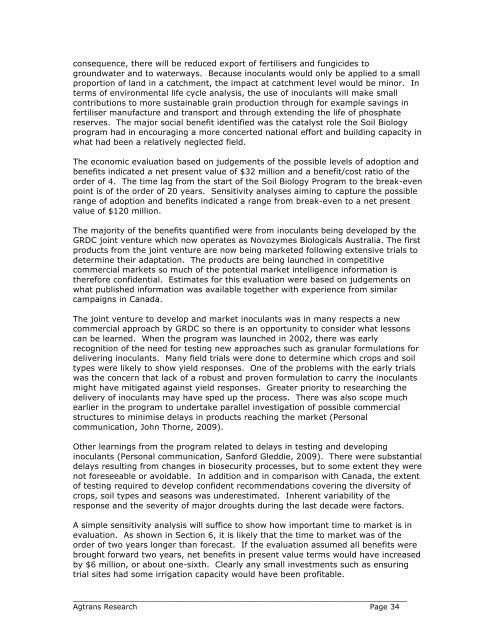impact assessment report series - Grains Research & Development ...
impact assessment report series - Grains Research & Development ...
impact assessment report series - Grains Research & Development ...
Create successful ePaper yourself
Turn your PDF publications into a flip-book with our unique Google optimized e-Paper software.
consequence, there will be reduced export of fertilisers and fungicides to<br />
groundwater and to waterways. Because inoculants would only be applied to a small<br />
proportion of land in a catchment, the <strong>impact</strong> at catchment level would be minor. In<br />
terms of environmental life cycle analysis, the use of inoculants will make small<br />
contributions to more sustainable grain production through for example savings in<br />
fertiliser manufacture and transport and through extending the life of phosphate<br />
reserves. The major social benefit identified was the catalyst role the Soil Biology<br />
program had in encouraging a more concerted national effort and building capacity in<br />
what had been a relatively neglected field.<br />
The economic evaluation based on judgements of the possible levels of adoption and<br />
benefits indicated a net present value of $32 million and a benefit/cost ratio of the<br />
order of 4. The time lag from the start of the Soil Biology Program to the break-even<br />
point is of the order of 20 years. Sensitivity analyses aiming to capture the possible<br />
range of adoption and benefits indicated a range from break-even to a net present<br />
value of $120 million.<br />
The majority of the benefits quantified were from inoculants being developed by the<br />
GRDC joint venture which now operates as Novozymes Biologicals Australia. The first<br />
products from the joint venture are now being marketed following extensive trials to<br />
determine their adaptation. The products are being launched in competitive<br />
commercial markets so much of the potential market intelligence information is<br />
therefore confidential. Estimates for this evaluation were based on judgements on<br />
what published information was available together with experience from similar<br />
campaigns in Canada.<br />
The joint venture to develop and market inoculants was in many respects a new<br />
commercial approach by GRDC so there is an opportunity to consider what lessons<br />
can be learned. When the program was launched in 2002, there was early<br />
recognition of the need for testing new approaches such as granular formulations for<br />
delivering inoculants. Many field trials were done to determine which crops and soil<br />
types were likely to show yield responses. One of the problems with the early trials<br />
was the concern that lack of a robust and proven formulation to carry the inoculants<br />
might have mitigated against yield responses. Greater priority to researching the<br />
delivery of inoculants may have sped up the process. There was also scope much<br />
earlier in the program to undertake parallel investigation of possible commercial<br />
structures to minimise delays in products reaching the market (Personal<br />
communication, John Thorne, 2009).<br />
Other learnings from the program related to delays in testing and developing<br />
inoculants (Personal communication, Sanford Gleddie, 2009). There were substantial<br />
delays resulting from changes in biosecurity processes, but to some extent they were<br />
not foreseeable or avoidable. In addition and in comparison with Canada, the extent<br />
of testing required to develop confident recommendations covering the diversity of<br />
crops, soil types and seasons was underestimated. Inherent variability of the<br />
response and the severity of major droughts during the last decade were factors.<br />
A simple sensitivity analysis will suffice to show how important time to market is in<br />
evaluation. As shown in Section 6, it is likely that the time to market was of the<br />
order of two years longer than forecast. If the evaluation assumed all benefits were<br />
brought forward two years, net benefits in present value terms would have increased<br />
by $6 million, or about one-sixth. Clearly any small investments such as ensuring<br />
trial sites had some irrigation capacity would have been profitable.<br />
_________________________________________________________________<br />
Agtrans <strong>Research</strong> Page 34

















